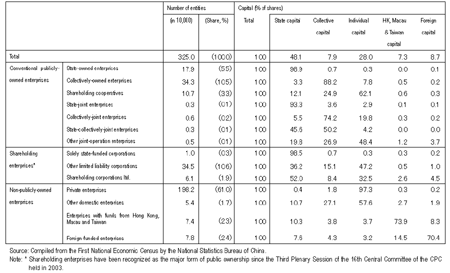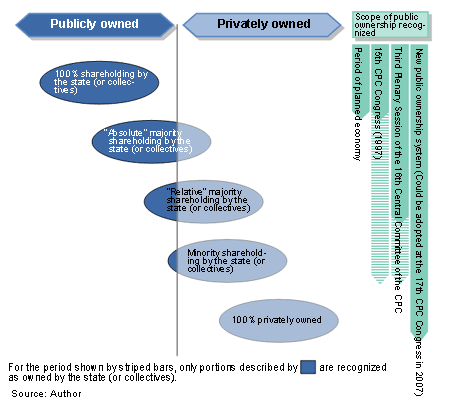"Public ownership of the means of production," along with "planned economy," has been the backbone of the conventional socialist economic system. Thus, in China under the planned economy, there only existed "publicly-owned enterprises" consisting of state-run enterprises (which were later renamed as state-owned enterprises) and collectively-owned enterprises, with no private enterprises allowed to be formed. Since the late 1970s when China adopted a reform and opening-door policy, however, both foreign companies and private enterprises began to grow. In particular, from the latter half of the 1990s, equity participation of private capital in, and privatization of, state-owned enterprises have been pushed forward through corporatization -- turning them into shareholding enterprises. China's transition to a market economy will not be completed until it abandons the public ownership system. In this regard, the ongoing shareholding reform is serving as the Trojan horse that leads to a private ownership system.
The "shareholding enterprises" as referred to here mean nothing but "corporations" generally adopted in capitalist countries. China began to introduce the shareholding system on a pilot basis in the 1980s as part of its efforts to reform state-owned enterprises. The Shanghai Stock Exchange was founded in 1990 and then the Shenzhen Stock Exchange in 1991, whereby many state-owned enterprises that had adopted the shareholding system have gone public with some of their shares acquired by private capital. At the Third Plenary Session of the 14th Central Committee of the Communist Party of China (CPC) in 1993, the establishment of a modern corporate system was adopted as a goal of the reform of state-owned enterprises. Then with the implementation of the Company Law in 1994, the full-scale transformation of state-owned enterprises into shareholding enterprises -- "solely state-funded," "other limited liability corporations," and "shareholding corporations limited" -- had begun. In particular, in line with the government's policy of "strategic realignment of the state-owned economy," set forth at the 15th National Congress of the CPC in 1997, private-sector equity participation in, and privatization of, state-owned enterprises have gathered pace. At the same time, shareholding enterprises purely funded by private capital have begun to grow rapidly. Hence, a "mixed economy" consisting of diverse forms of ownership is taking shape ( table ).
Based on conventional ideology, the existence of large corporations is the very symbol of capitalism, a deviation from the public ownership of the means of production that constitutes the foundation of socialism. However, the government's official line is that corporations are just one of many diverse forms of modern enterprises and can be used by any country, whether capitalist or socialist (as stated by Jiang Zemin in his report before the 15th CPC Congress in 1997). Furthermore, the definition of the public ownership system has been evolving over time ( chart ). First, at the 15th CPC Congress, it was decided that state-owned (or collectively-owned) portions of shareholding enterprises -- as corporations are called in China -- should be accepted as part of the publicly-owned economy. Furthermore, at the Third Plenary Session of the 16th Central Committee of the CPC held in October 2003, the shareholding system was recognized as the major form of public ownership, whereby an enterprise controlled by the state (or collectives), as a whole, came to be recognized as part of the publicly-owned economy even if the state ownership falls short of 50% (or absolute majority), provided that the state holds greater shares than any other shareholders (relative majority).
In response to such development, economists have been actively debating what the public ownership system is supposed to be. Among various arguments, a "theory of a new public ownership system" put forward by Li Yining, a prominent economist and professor at the Guanghua School of Management of Peking University, has attracted much public attention. Professor Li interprets the ongoing reform of state-owned enterprises, centering on corporatization, not as a process toward privatization but as a realignment/development process toward a new public ownership system. He proposes that shareholding enterprises purely funded by private capital should also be considered one of various forms of this new public ownership system. Some economists who insist maintaining public ownership are critical of Professor Li's proposal, which they say has distorted the meaning of "public ownership."
The same criticism, though to a different extent, would also be applicable to the government's official line that has deviated from the conventional ideology of socialism. With the Chinese economy's center of gravity steadily shifting from public ownership to private-ownership, and the contradictions between the "economic base" and the "superstructure" deepening, however, it is becoming difficult for the government to maintain the official principle of "public ownership of the means of production." It is now being pressed to further expand the scope of public ownership in accordance with Professor Li's proposal, and eventually will have to abandon that principle altogether. Since the planned economy was officially replaced by the market economy at the 14th CPC Congress in 1992, adherence to public ownership has been the biggest obstacle hindering productivity growth, and its abandonment will certainly trigger further leaps of the Chinese economy.
 click to enlarge
click to enlarge
 click to enlarge
click to enlarge


